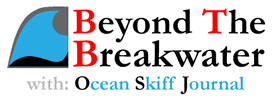Now we’re down to the serious stuff – what flies will you tie to the end of your line? There are literally thousands of salt water patterns around – which ones should you choose for fishing BTB? This post is part of an ongoing series focused on getting started in saltwater fly fishing in Southern California. Past posts included equipment guidelines, connecting everything up, and what to wear when going offshore.
The answer is not as complicated as you might think. What you’ll discover is that there are only a few basic styles of flies that you need to cover most of the bases. As before, once you’re on the water and build confidence, you’ll gravitate to styles, dressings, and colors that suit your needs or style of fishing. Every now and then, a new style will show up that you really like, and it will become part of your toolkit.
That said, let’s start with a discussion of the different fly styles…
What You Need to Get Started Is…
The Slim Baitfish:

A sparse Half-and-Half
is a basic streamer that simulates a fairly skinny baitfish (anchovy, sardine, saurie, small fry). It should have these characteristics:
- It should be available in lengths from 2″ to 6″
- It should be available in various baitfish color schemes (see below)
- It should have fairly large eyes
- It should be tied so it has minimal fouling on the cast
- It should be available in sparsely-tied to heavily-tied versions
- Typical examples: Clouser Minnow, Lefty’s Deceiver, Half-and-Half, ALF, Sar-Mul-Mac, Mushmouth, Sea Habit (regular and Deceiver versions), Tuna Kahuna, Surf Candy
The Wide Baitfish:

Matt Hale’s Queenfish
means a basic streamer that simulates a baitfish with a deeper, more vertical profile (queenfish or tomcod, perch). It should have these characteristics:
- It should be available in lengths from 3″ to 6″
- It should be available in various baitfish color schemes (see below)
- It should have fairly large eyes
- It should be tied so it has minimal fouling on the cast
- It should be available in sparsely-tied to heavily-tied versions
- Typical examples: Whistler, Hollow Fleyes, Hale Queenfish…
The Surface Fly:

Crease Fly
means a fly that floats, and is designed to be worked on the surface. Key features include
- Durable construction, large enough gap to provide solid hookups (not too much body below the hook shank)
- These types of flies can have several potential types of action: popping/splashing, a darting side-to-side action (popping or not), a diving action with subtle popping
- It should be available in a basic baitfish color scheme, plus all-white and all-yellow
- Typical examples: Curcione Catamaran Popper, Crease Fly, Bob’s Banger, Gurgler

